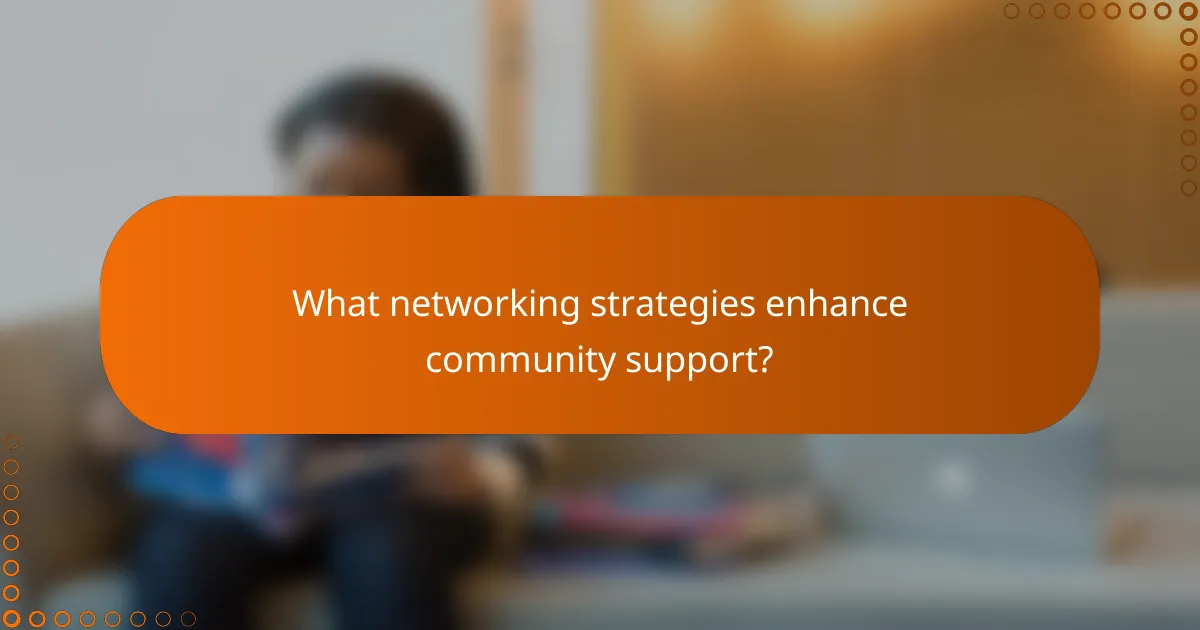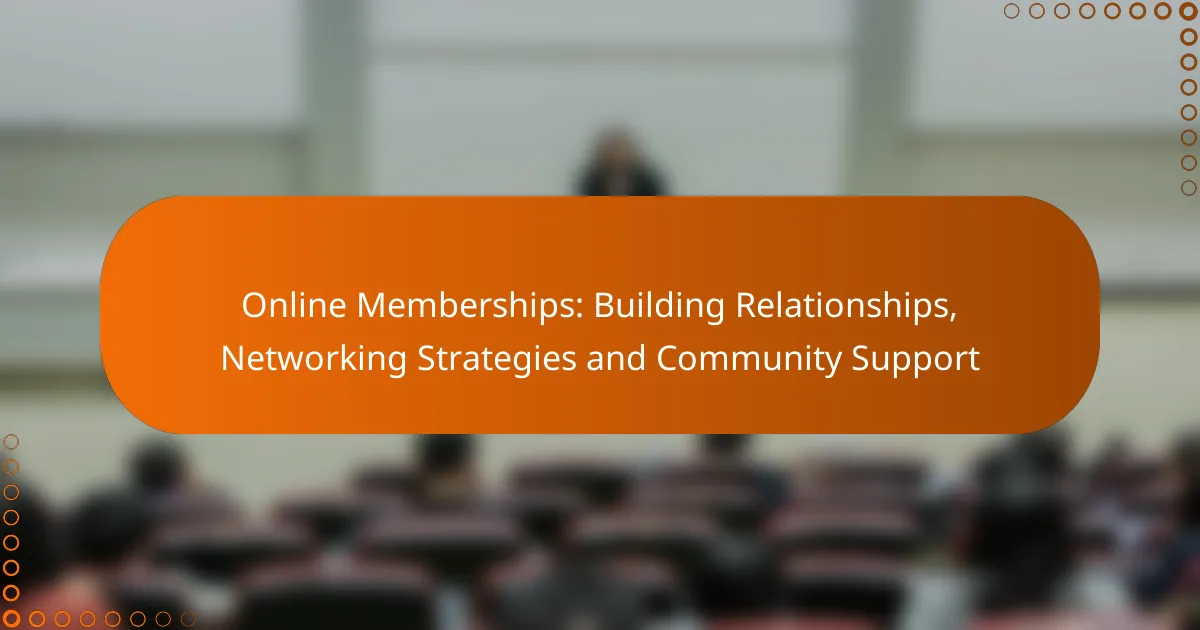Online memberships are a powerful way to cultivate relationships and foster community support among members. By creating a vibrant environment that encourages interaction and provides exclusive resources, organizations can enhance engagement and satisfaction. Implementing effective networking strategies, such as hosting events and collaborating with key influencers, further strengthens these connections and builds a loyal community.

How to build effective online memberships?
Building effective online memberships involves creating a strong sense of community and providing valuable content that keeps members engaged. Focus on utilizing platforms, offering exclusive materials, and fostering interaction to enhance relationships and networking opportunities.
Utilizing platforms like Patreon
Platforms such as Patreon allow creators to monetize their content while building a dedicated membership base. By offering various subscription tiers, you can cater to different audience segments and provide tailored benefits that encourage ongoing support.
Consider the features of each platform, such as payment processing fees and audience reach. For instance, Patreon takes a percentage of earnings, so factor this into your pricing strategy to ensure sustainability.
Creating exclusive content
Exclusive content is a key driver for attracting and retaining members. This can include behind-the-scenes access, early releases, or unique tutorials that are not available to the general public. The goal is to provide value that justifies the membership fee.
When developing exclusive content, think about your audience’s interests and needs. Regularly update this content to keep it fresh and engaging, ensuring members feel they are receiving ongoing value.
Engaging through webinars
Webinars are an effective way to engage members and build community. They provide a platform for real-time interaction, allowing members to ask questions and participate in discussions. This direct engagement fosters a sense of belonging and loyalty.
Plan your webinars around topics that resonate with your audience. Promote them in advance and consider recording sessions for those who cannot attend live, ensuring all members have access to valuable insights.
Implementing tiered membership levels
Tiered membership levels allow you to offer different benefits based on the subscription price, catering to various member needs and budgets. This approach can increase overall membership by appealing to a wider audience.
When designing tiers, clearly outline the benefits at each level. For example, a basic tier might include access to a community forum, while a premium tier could offer one-on-one consultations or exclusive workshops. This clarity helps potential members understand the value of each option.

What networking strategies enhance community support?
Effective networking strategies that enhance community support include leveraging online platforms, hosting engaging events, and collaborating with influential figures. These approaches foster connections, encourage participation, and build a sense of belonging among members.
Leveraging LinkedIn groups
LinkedIn groups serve as a powerful tool for networking and community support. By joining or creating groups relevant to your niche, you can connect with like-minded professionals, share insights, and discuss industry trends.
To maximize engagement, actively participate in discussions, post valuable content, and encourage members to share their experiences. This not only strengthens relationships but also positions you as a knowledgeable resource within the community.
Hosting virtual meetups
Virtual meetups allow for real-time interaction and relationship building among community members. Platforms like Zoom or Microsoft Teams can facilitate these gatherings, enabling participants to share ideas and network effectively.
Consider organizing themed meetups or workshops that address specific topics of interest. This targeted approach can enhance participation and create a more engaged community. Ensure to follow up with attendees to maintain connections and gather feedback for future events.
Collaborating with influencers
Collaborating with influencers can significantly boost your community’s visibility and credibility. Identify influencers within your niche who align with your values and have an engaged audience.
Work together on projects, webinars, or content creation to leverage their reach. This partnership can attract new members and enhance community support by providing fresh perspectives and insights. Always ensure that collaborations are authentic and beneficial for both parties involved.

What are the benefits of online memberships?
Online memberships offer numerous advantages, including enhanced engagement, access to exclusive resources, and the opportunity to build a loyal community. These benefits can significantly improve member satisfaction and retention, making online memberships a valuable investment for organizations.
Increased member engagement
Online memberships foster increased member engagement by providing interactive platforms for communication and collaboration. Members can participate in forums, webinars, and live events, which encourage active involvement and connection with others.
To maximize engagement, organizations should regularly update content and create opportunities for members to contribute, such as polls or discussion topics. This keeps the community vibrant and encourages members to return frequently.
Access to exclusive resources
Members often gain access to exclusive resources that are not available to the general public. These resources can include specialized training materials, industry reports, or discounts on products and services relevant to the membership’s focus.
Organizations should clearly communicate the value of these resources to attract new members. Regularly refreshing the offerings can also help maintain interest and ensure members feel they are receiving ongoing value.
Building a loyal community
Online memberships are effective for building a loyal community by creating a sense of belonging among members. When individuals feel connected to a group, they are more likely to remain engaged and committed over time.
To strengthen community ties, organizations can facilitate networking opportunities, such as virtual meetups or mentorship programs. Recognizing member achievements and encouraging collaboration can further enhance loyalty and foster a supportive environment.

How to choose the right membership platform?
Choosing the right membership platform involves assessing your specific needs, such as features, pricing, and ease of use. Consider how the platform aligns with your goals for community engagement, content delivery, and member management.
Comparing features of MemberPress
MemberPress is known for its robust feature set, including content protection, subscription management, and integration with various payment gateways. It allows you to create different membership tiers, providing flexibility in how you monetize your content.
Key features to consider include customizable membership options, automated billing, and detailed reporting tools. These functionalities help streamline operations and enhance user experience, making it easier to manage your community effectively.
Evaluating pricing of Kajabi
Kajabi’s pricing is structured in tiers, typically ranging from mid to high monthly costs, depending on the features you choose. Each tier offers different capabilities, such as advanced marketing tools and automation features, which can significantly impact your overall budget.
When evaluating Kajabi, consider the value of included features against your specific needs. For example, if you require extensive marketing automation, investing in a higher tier may yield better returns through increased member engagement and retention.

What are the key criteria for successful online communities?
Successful online communities thrive on clear objectives, effective communication, and active engagement among members. These criteria help foster relationships, facilitate networking, and provide essential support within the community.
Defining community goals
Establishing clear community goals is crucial for guiding activities and member interactions. Goals should be specific, measurable, achievable, relevant, and time-bound (SMART) to ensure they resonate with members and drive participation.
For example, a community focused on professional development might aim to host monthly webinars and create a resource library within six months. Regularly revisiting and adjusting these goals keeps the community aligned with members’ evolving needs.
Establishing clear communication channels
Effective communication channels are essential for maintaining engagement and facilitating discussions. Consider using platforms like forums, social media groups, or dedicated messaging apps to ensure members can easily connect and share information.
It’s important to set guidelines for communication to foster a respectful and constructive environment. Encourage members to participate in discussions while also providing them with the tools to share feedback and suggestions for improvement.

How to measure the success of an online membership?
Measuring the success of an online membership involves evaluating various metrics that reflect member engagement, retention, and satisfaction. Key indicators include member retention rates, engagement levels, and feedback from members.
Tracking member retention rates
Member retention rates are crucial for assessing the longevity and satisfaction of your online membership. This metric indicates the percentage of members who continue their subscriptions over a specific period, typically measured monthly or annually.
To calculate retention rates, divide the number of members at the end of a period by the number of members at the start of that period, then multiply by 100. For example, if you start with 100 members and end with 80 after a year, your retention rate is 80%.
To improve retention, focus on providing value through quality content, community engagement, and personalized communication. Regularly survey members to understand their needs and adapt your offerings accordingly. Aim for retention rates above 70% to indicate a healthy membership base.
